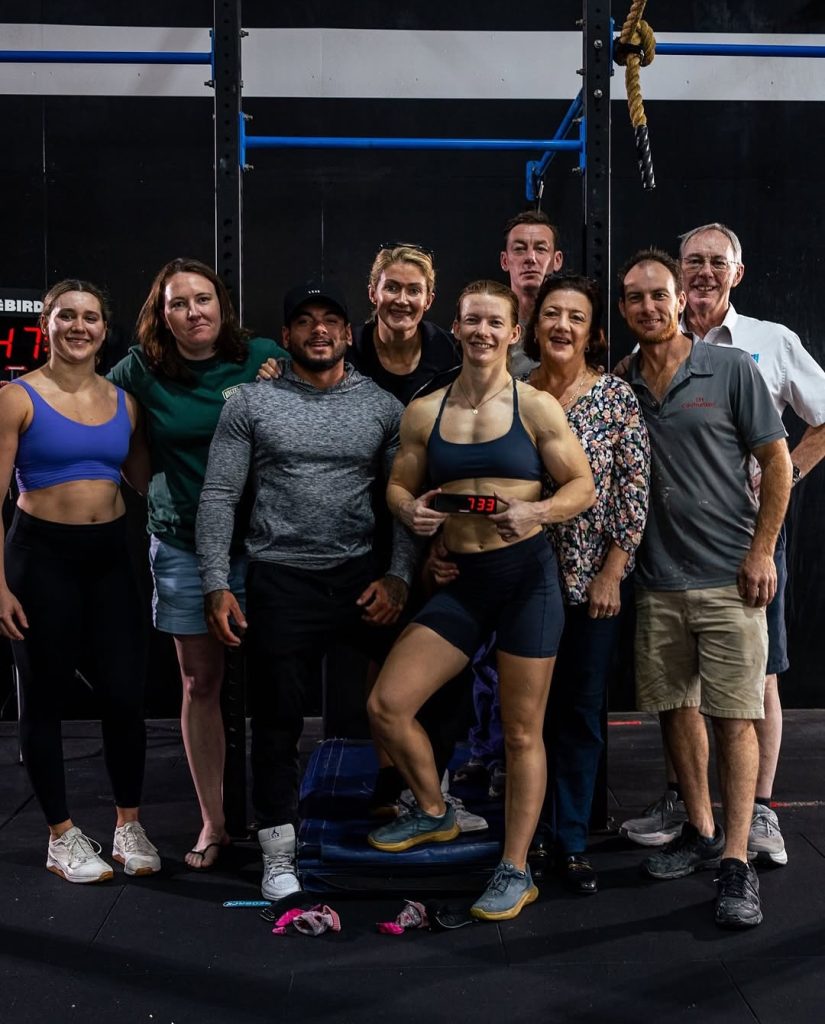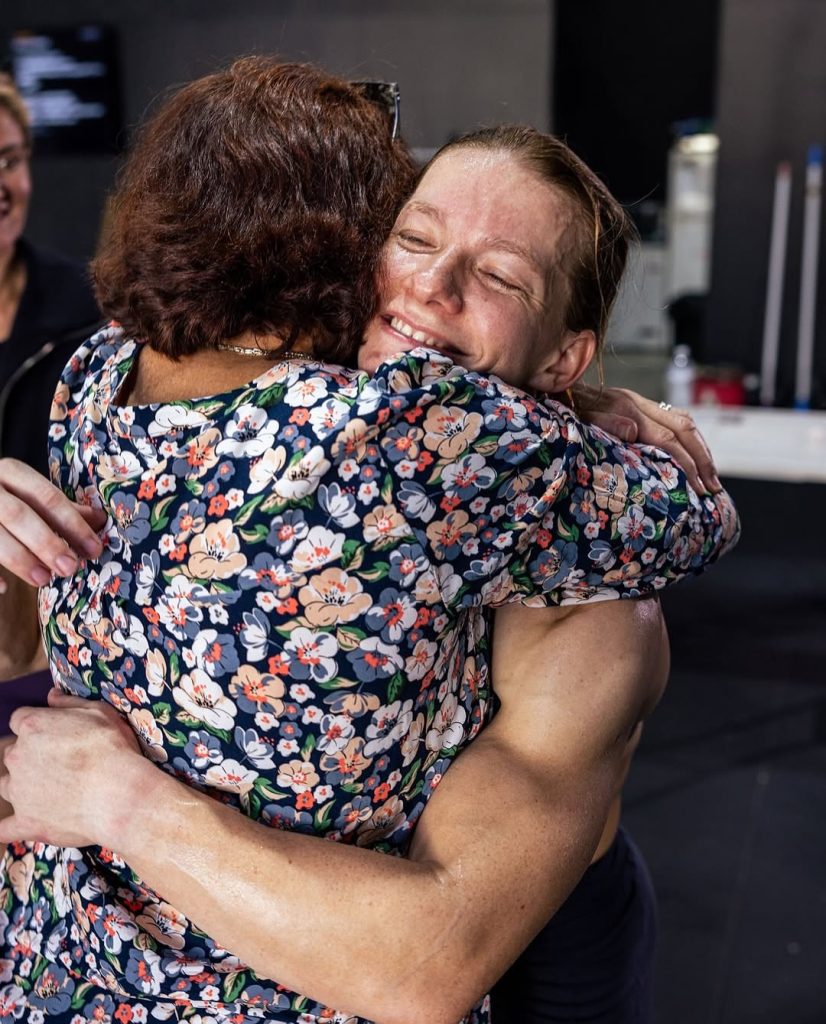She Tore Her Bicep, Refused to Quit, and Then Broke the World Record—Meet the Australian Cop Who Just Hit 733 Pull-Ups in One Hour
When most people think about pull-ups, they picture a movement that is already brutally challenging in small numbers. A handful of strict reps can leave the arms shaking, the shoulders burning, and the breath short. But on a quiet stretch of the Gold Coast, inside a gym filled with tension, chalk dust, and the unmistakable hum of anticipation, one Australian police officer pushed far beyond what most consider possible. Senior Constable Jade Henderson of the Queensland Police Service walked up to a pull-up bar on what seemed like an ordinary day and carved her name into world-record history. In just one hour, she completed 733 unassisted pull-ups, officially setting a new women’s world record and breaking the previous mark of 725 that had stood since 2016.

What makes Henderson’s feat even more astonishing is the personal storm she fought leading up to it. Months earlier, she had been deep in preparation for a grueling 24-hour pull-up challenge — a test of strength, discipline, and mental endurance so brutal that even elite athletes hesitate before attempting it. That was when she tore her bicep, a devastating injury that could have shut down the plans of almost anyone. For Henderson, the injury was not just physically painful but emotionally crushing. Athletes often describe injuries as moments that steal momentum, confidence, and identity. But Henderson carried something different: a sense of unfinished work and a belief that her body, even while healing, had more to give.

She shifted her mindset and scaled her target. Instead of the 24-hour challenge she had trained for, she set her sights on the one-hour world record — an achievement that still required extraordinary physical ability and iron-clad mental focus. The numbers alone reveal the mountain she decided to climb. To hit 733 pull-ups in 60 minutes, Henderson had to average more than 12 clean, unassisted reps every single minute. That means no break longer than a few seconds, no slump in technique, no faltering under the reality that each minute carries the weight of a full workout for most people.

Witnesses describe the atmosphere inside the training facility as electric. The air smelled faintly of chalk and disinfectant, and the pull-up bar — the simplest piece of equipment — suddenly felt like a monument. Henderson walked in with her hair tied back, her arms wrapped and prepared, her expression calm but charged with purpose. She didn’t show theatrics or bravado. Those watching recall something steadier: a focus so sharp that it was almost visible, as though she had mentally locked into a channel only she could hear.
The timer began, and she performed her first set with the kind of control and strength that immediately set the tone. By the tenth minute, her rhythm looked almost mechanical — quick ascents, steady descents, nothing wasted. Sweat darkened the mat beneath her as each rep carved another tiny notch in her journey toward history. The room erupted in cycles: moments of loud encouragement, then sudden quiet as the realization set in that she was on pace to break the record if she could simply endure the pain.

Endurance, of course, is where feats like this truly happen. Strength gets an athlete through the first several minutes. But after that, what remains is a blend of discipline, grit, pain tolerance, breath control, and a willingness to suffer with purpose. Henderson seemed to understand this intimately. Observers noted that at around the halfway mark — close to 30 minutes in — her arms began to swell, her shoulders reddened from friction and strain, and her breathing shifted to deeper, more controlled cycles. She continued anyway, never fully breaking rhythm.
At the 40-minute point, the reality of the challenge began to show itself. Her face tightened. Her grip started to slip between sets. Chalk dust coated her hands in uneven streaks. A lesser athlete might have cracked under the weight of what was still left to do. But Henderson turned inward again, according to coaches present that day. They described seeing her mentally re-engage with a level of determination that felt almost athletic in itself — the kind of internal fire that separates record-breakers from everyone else.
She passed the previous world record before the final minute. The room erupted in cheers, applause, and disbelief, but Henderson did not stop. For the last stretch of the hour, she kept pulling, rep after rep, as though somehow the work mattered even more once the goal was secure. When the timer finally sounded, her body slumped for the first time in an hour. Her arms hung at her sides, trembling. Her breathing was heavy, but the exhaustion carried something luminous — a kind of relief mixed with triumph.

The count came in: 733 pull-ups. A new world record. A shattered barrier. A moment of history that belonged not only to strength, but to resilience.
It didn’t take long for the story to spread beyond the Gold Coast gym. Fellow officers from the Queensland Police Service flooded her with messages of support, pride, and congratulations. Police work is demanding, both mentally and physically, and Henderson’s accomplishment resonated with colleagues who understand the discipline her achievement represents. Her feat quickly reached fitness communities around the world, where athletes and trainers praised her precision, form, and mental toughness. Although social media is often a place where extraordinary accomplishments are met with skepticism, Henderson’s performance carried the credibility of official verification and clear evidence. The reactions were overwhelmingly celebratory, with many calling her effort one of the most impressive displays of human endurance seen in years.
Henderson herself expressed gratitude and humility in the aftermath. She acknowledged the difficulty of the road leading up to the attempt and admitted that the bicep injury nearly derailed everything. But she also emphasized something deeper — that recovery, training, and focus can realign the path, even when the original one is lost. While she avoided dramatic language, those close to her said the record symbolized a personal reclamation of strength after a setback that might have ended the dream entirely.

What makes Henderson’s accomplishment even more remarkable is that it takes place in a fitness era increasingly dominated by shortcuts, flashy trends, and quick transformations. Pull-ups are not glamorous. They are not easy to market. They rely on no elaborate machines, no special programming, and no modern reinvention. They are one of the oldest, purest tests of upper-body strength and muscular endurance: your body against gravity, again and again.
By excelling in such a fundamental movement — and doing it with staggering volume — Henderson elevated something simple into something monumental. It was a reminder that the most profound athletic achievements often come from the basics, performed with extraordinary discipline.
Her performance also sparked conversations about the mental side of elite fitness. Coaches and psychologists frequently note that in long-duration strength challenges, the brain becomes the primary battlefield. Pain signals fire constantly. Muscles reach the edge repeatedly. Doubt tries to creep in. Henderson pushed through all of that. Observers watching her attempt said that the shift from strength to endurance to survival was visible — a rare, raw window into what the human body can do when the mind refuses to let go.
Even in the aftermath, when her body finally relaxed and the adrenaline faded, Henderson remained composed. She smiled, laughed with those around her, and sipped water with the calmness of someone who had just proven something to herself that no title could replicate. Records can be broken again someday. But the journey she walked — from injury to world-class triumph — is something no one can take away from her.
Today, Senior Constable Jade Henderson stands not just as a world record-holder, but as a symbol of perseverance. Her achievement is already inspiring athletes, officers, and everyday people who understand what it means to fight back from a setback. Her story is a reminder that heroism is not always dramatic or loud. Sometimes it takes the shape of a single bar, a relentless rhythm, and a woman who refuses to stop pulling herself upward.

